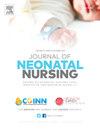早产儿母亲袋鼠式护理实践效果:知识、感知、障碍和依恋的有效性
Q2 Nursing
引用次数: 0
摘要
目的本研究旨在了解母亲依恋与早产儿袋鼠式护理(KC)之间的知识、认知、障碍以及关系。患者与方法采用非等效对照组设计,对云南省科尼亚市3家国立医院新生儿重症监护病房的104名早产儿母亲进行比较。参与者被分为KC组(n = 62)和非KC组(n = 42)。使用个人信息表、KC问卷和母亲依恋量表(MAI)收集数据。结果孕妇(平均年龄27.69±6.44岁,剖腹产率66.1%)所生婴儿出生体重明显增高(p = 0.008)。各组在KC知识、认知和障碍方面的许多反应也存在差异。KC母亲的MAI得分也较高(p = 0.001,效应量= 0.613)。产妇依恋受KC状态、胎龄、出生体重和住院时间的显著影响,解释了36.5%的MAI方差(F = 14.229, p = 0.001)。结论应进一步研究基于方案的KC对母亲的长期影响。本文章由计算机程序翻译,如有差异,请以英文原文为准。
Kangaroo care practice outcome of mothers with premature infant: The effectiveness on knowledge, perception, barrier and attachment
Purpose
This study aimed to determine mothers’ knowledge, perceptions, barriers, and the relationship between maternal attachment and kangaroo care (KC) practices for preterm infants.
Patients and methods
A nonequivalent comparison group design was conducted with 104 mothers of preterm neonates in NICUs of three state hospitals in Konya, Türkiye. Participants were assigned to KC (n = 62) and non-KC (n = 42) groups. Data were collected using a personal information form, a KC questionnaire, and the Maternal Attachment Inventory (MAI).
Results
KC mothers (mean age 27.69 ± 6.44, had C-sections 66.1 %) had infants with significantly higher birth weight (p = 0.008). Groups also differed in many responses regarding KC knowledge, perceptions, and barriers. KC mothers also had higher MAI scores (p = 0.001, effect size = 0.613). Maternal attachment was significantly influenced by KC status, gestational age, birth weight, and hospitalization length, explaining 36.5 % of MAI variance (F = 14.229, p = 0.001).
Conclusions
Further research should investigate the long-term effects of protocol-based KC on mothers.
求助全文
通过发布文献求助,成功后即可免费获取论文全文。
去求助
来源期刊

Journal of Neonatal Nursing
Nursing-Pediatrics
CiteScore
2.00
自引率
0.00%
发文量
143
期刊介绍:
Aims & Scope: This is the practical, bimonthly, research-based journal for all professionals concerned with the care of neonates and their families, both in hospital and the community. It aims to support the development of the essential practice, management, education and health promotion skills required by these professionals. The JNN will provide a forum for the exchange of ideas and information between the range of professionals working in this field; promote cooperation between these professionals; facilitate partnership care with families; provide information and informed opinion; promote innovation and change in the care of neonates and their families; and provide an education resource for this important rapidly developing field.
 求助内容:
求助内容: 应助结果提醒方式:
应助结果提醒方式:


